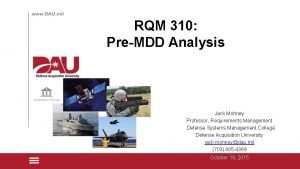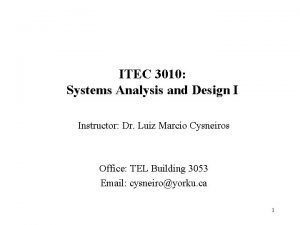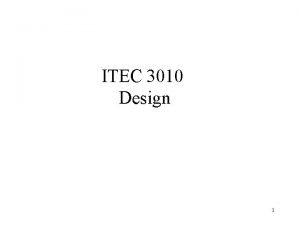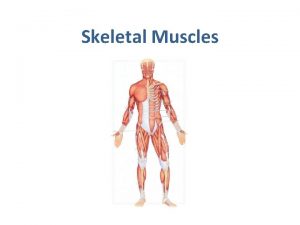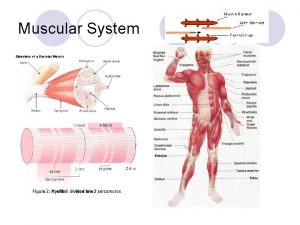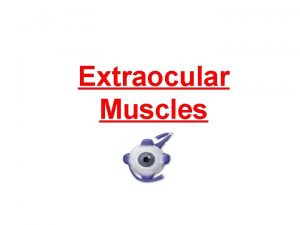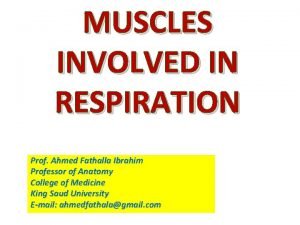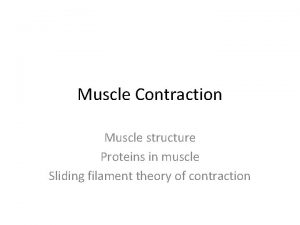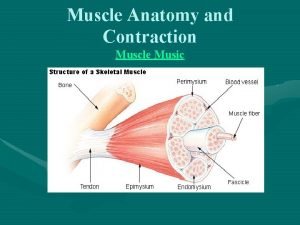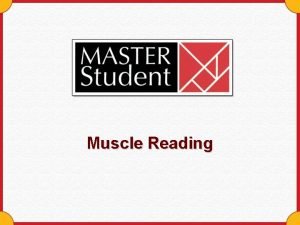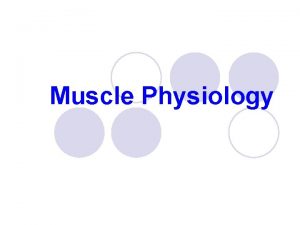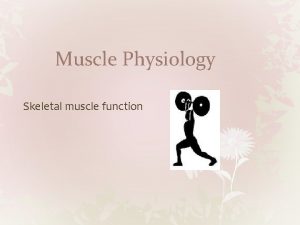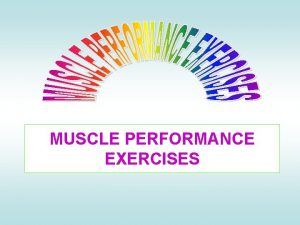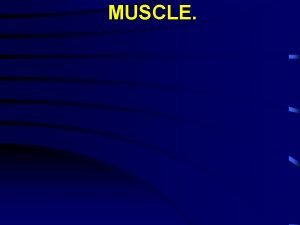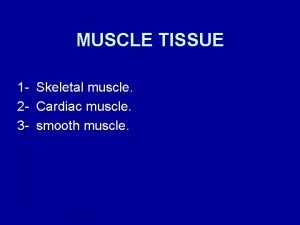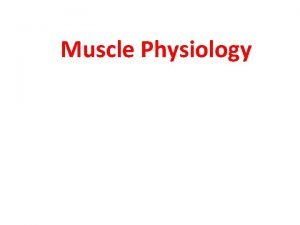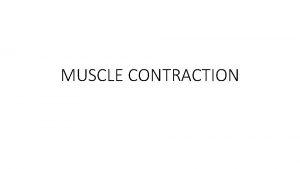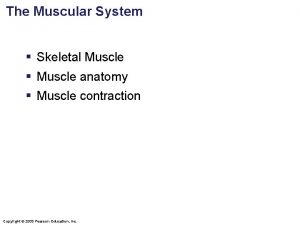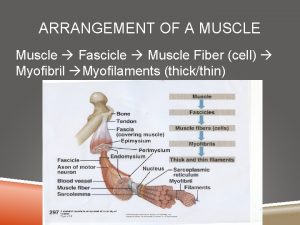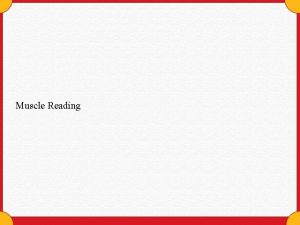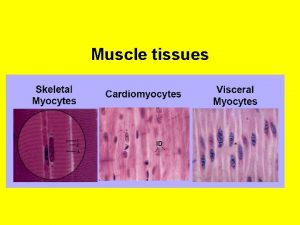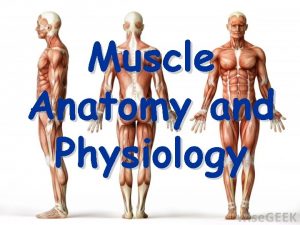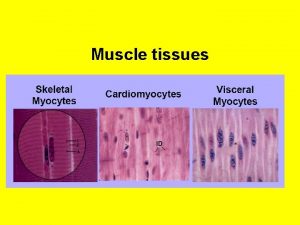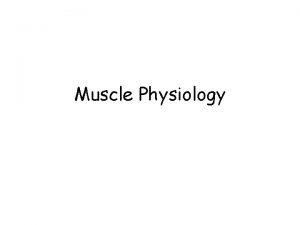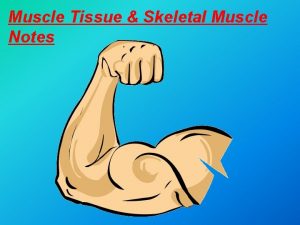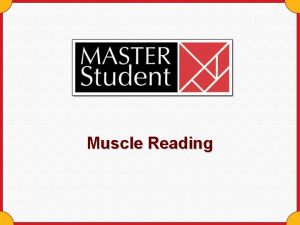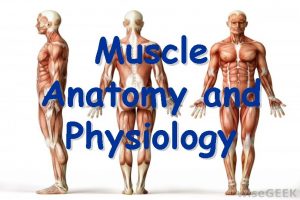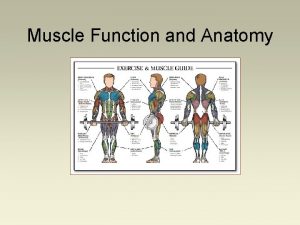REC 3010 HUMAN MOVEMENT THE STRUCTURE OF MUSCLE




































- Slides: 36

REC 3010 HUMAN MOVEMENT

THE STRUCTURE OF MUSCLE

CONNECTIVE TISSUE/FASCICLES

AGONIST AND ANTAGONIST MUSCLES

Agonist-Antagonist Muscles Upper Trapezius Levator Scapulae Middle Trapezius Rhomboid Minor Serratus Anterior Rhomboid Major Lower Trapezius The Upper Trapezius and the Lower Trapezius have an Agonist-Antagonist relationship

Agonist-Antagonist Muscles Glenohumeral joint Greater Tubercle Lesser Tubercle Subscapularis Supraspinatus Infraspinatus Teres Minor The Subscapularis and the Supraspinatus/Infraspinatus/Teres Minor have a Agonist Antagonist relationship

The muscles of the Abdominals are opposite the Lower Back External Abdominal Oblique Pectoralis Major Rectus Abdominal Internal Abdominal Oblique Transverse Abdominis Tendinous Transcriptions Longissimus Spinalis Iliocostalis The Transverse Abdominals are opposite each other

There are some interesting Agonist Antagonist relations between the Hip Extensors and the Hip Flexors Semimembranosus Semitendonosus Biceps Femorus Vastus Lateralis Vastus Medialis Vastus Intermedialis Vastus Lateralis

AGONIST/ANTAGONIST STRENGTH RATIOS

ACTIN & MYOSIN FILAMENTS (SLIDING FILAMENT THEORY)

ACTIN & MYOSIN FILAMENTS

SARCOMERE DIAGRAM


MYOSIN CROSS BRIDGE IN ACTION

MUSCLE CONTRACTION/RELAXATION

NEUROMUSCULAR JUNCTION

PRODUCING A MUSCLE ACTION

ISOTONIC CONTRACTION *CONCENTRIC CONTRACTION -muscle acts as moving force -muscle shortens creating tension -motion is created *ECCENTRIC CONTRACTION -muscle acts as a resistive force -external force exceeds contractive force -muscle lengthens & motion is slowed ISOMETRIC CONTRACTION - -muscle tension is created with no movement -resistance comes from opposing muscle, gravity or an immoveable object -motion is prevented by equal opposing forces

WHICH MUSCLES ACT AS • There are three lever classes. • The body operates primarily as a series of third-class levers, with only a few first - and second-class levers. – Force (F) acts between the axis (X) and the resistance (R) ST 1 & ND 2 ?

LEVERS OF THE BODY 1 ST CLASS LEVER 2 ND CLASS LEVER 3 RD CLASS LEVER

ST 1 CLASS LEVER

ND 2 THE WEIGHT OF THE BODY PROVIDES THE REISISTANCE LOAD CLASS LEVER WHEN THE CALF CONTRACTS IT PROVIDES THE EFFORT FORCE THE FOOT ACTS AS THE RESISTANCE ARM THE BALL OF FOOT ACTS AS FULCRUM OR AXIS OF ROTATION

7 Principles of Biomechanics Principle #1: Stability The lower the center of mass the larger the base of support the closer the center of mass to the base of support & the greater the mass The more stability increases Example: Sumo Wrestler Principle #2: Maximum Effort The production of maximum force requires the use of all possible joint movements that contribute to the tasks objective Example: Bench Press or Golf

Principle #3: Maximum Velocity The production of maximum velocity requires the use of joints in order from largest to smallest Example: Slap Shot or Golf Drive Principle #4: Linear Motion The greater the applied impulse the greater the increase in velocity Example: Slam Dunking in Basketball Principle #5: Linear Motion Movement usually occurs in the direction opposite of the applied force Example: High Jumper, Runners & Cyclists

Principle #6: Angular Motion Angular motion is produced by the application of a force acting at some distance from the axis, that is, by torque The production of Angular Motion Example: Baseball Pitcher Principle #7: Angular Momentum is constant when an athlete or object is free in the air. Once an athlete is airborne, he or she will travel with a constant angular momentum. Example: Divers

Anatomical, Directional, and Regional Terms

Movement of the Skeleton • There are three main types of joints: – Fibrous joints – Cartilaginous joints – Synovial joints • Synovial joint movement occurs within the three planes of motion: sagittal, frontal, and transverse. – Movement occurs along the joint’s axis of rotation, where the plane of movement is generally perpendicular to the axis. – Uniplanar joints (hinge joints) allow movement in only one plane. – Biplanar joints allow movement in two planes that are perpendicular to each other. – Multiplanar joints allow movement in all three planes.

Movement in the Sagittal Plane § The sagittal plane runs anterior-posterior, dividing the body into left and right sections. § Movements that involve rotation about a mediolateral axis occur in the sagittal plane. Examples include: – – Flexion Extension Dorsiflexion Plantarflexion

Movement in the Frontal Plane • • The frontal plane runs laterally, dividing the body into anterior and posterior sections. Movements that involve rotation about an anteroposterior axis occur in the frontal plane. Examples include: – – – Abduction Adduction Elevation Depression Inversion Eversion

Movement in the Transverse Plane § § The transverse plane runs horizontally, dividing the body into superior and inferior sections. Movements that involve rotation about a longitudinal axis occur in the transverse plane. Examples include: – – – Rotation Pronation Supination Horizontal flexion Horizontal extension

Movement of Synovial Joints

Angular Movements *Flexion *Extension *Abduction *Adduction

Circular Movements *Circumduction *Rotation

Movements Special to the Shoulder *Protraction *Retraction *Elevation *Depression

Movements Special to the Ankle *Inversion *Eversion *Dorsiflexion *Planterflexion

Anatomical Position
 Cjcsi 3010
Cjcsi 3010 Ad systems exam slide
Ad systems exam slide Ai processor
Ai processor First-cut design class diagram
First-cut design class diagram Smooth muscle cells
Smooth muscle cells What muscle fibers run in circles around your eye
What muscle fibers run in circles around your eye Muscle fixator
Muscle fixator Passive insufficiency of hamstrings
Passive insufficiency of hamstrings Connections of ciliary ganglion
Connections of ciliary ganglion Fiber direction of external intercostal muscles
Fiber direction of external intercostal muscles Movement and non-movement area
Movement and non-movement area Axial movement examples
Axial movement examples Myo muscle
Myo muscle How many bones in an adult body
How many bones in an adult body Extensors of leg
Extensors of leg Hình ảnh bộ gõ cơ thể búng tay
Hình ảnh bộ gõ cơ thể búng tay Frameset trong html5
Frameset trong html5 Bổ thể
Bổ thể Tỉ lệ cơ thể trẻ em
Tỉ lệ cơ thể trẻ em Voi kéo gỗ như thế nào
Voi kéo gỗ như thế nào Tư thế worm breton là gì
Tư thế worm breton là gì Chúa sống lại
Chúa sống lại Các môn thể thao bắt đầu bằng tiếng chạy
Các môn thể thao bắt đầu bằng tiếng chạy Thế nào là hệ số cao nhất
Thế nào là hệ số cao nhất Các châu lục và đại dương trên thế giới
Các châu lục và đại dương trên thế giới Công thức tính thế năng
Công thức tính thế năng Trời xanh đây là của chúng ta thể thơ
Trời xanh đây là của chúng ta thể thơ Mật thư anh em như thể tay chân
Mật thư anh em như thể tay chân Làm thế nào để 102-1=99
Làm thế nào để 102-1=99 Phản ứng thế ankan
Phản ứng thế ankan Các châu lục và đại dương trên thế giới
Các châu lục và đại dương trên thế giới Thể thơ truyền thống
Thể thơ truyền thống Quá trình desamine hóa có thể tạo ra
Quá trình desamine hóa có thể tạo ra Một số thể thơ truyền thống
Một số thể thơ truyền thống Cái miệng bé xinh thế chỉ nói điều hay thôi
Cái miệng bé xinh thế chỉ nói điều hay thôi Vẽ hình chiếu vuông góc của vật thể sau
Vẽ hình chiếu vuông góc của vật thể sau Biện pháp chống mỏi cơ
Biện pháp chống mỏi cơ
